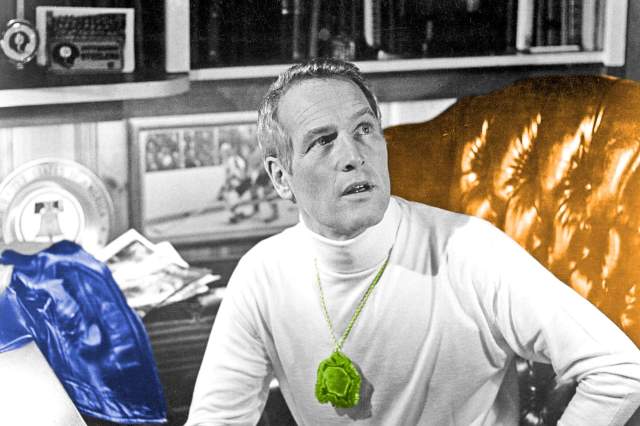
Paul Newman Narrowly Avoided Death in World War II
Newman spent the bulk of his World War II service time as a radioman and aircraft gunner, and while his duties kept him away from major combat action, he narrowly avoided a truly disastrous outcome. As described in Shawn Levy’s Paul Newman: A Life, the future actor was assigned to flight exercises off the USS Bunker Hill aircraft carrier in the Pacific, but his plane was grounded when the pilot developed an ear infection. That meant Newman missed the action that happened a few days later: On May 11, 1945, nearly 400 servicemen were killed by a pair of Japanese kamikaze attacks on the Bunker Hill, including every present member of Newman’s squadron.

Newman Publicly Apologized for His First Film Role
While many actors dream of landing their first featured film role, the experience was a nightmare for Newman. Tapped to star in The Silver Chalice (1954) as a Greek silversmith who fashions a cup to commemorate Jesus Christ at the Last Supper, the Hollywood newcomer butted heads with director Victor Saville and never found a comfort zone in matters ranging from delivering dialogue to riding a camel. He later called it “the worst film to be made in the entirety of the 1950s.” While Newman eventually overcame this early career hurdle, the rising star was aghast to learn that a Los Angeles television station was airing The Silver Chalice in 1963. As a result, according to A Life, Newman took out ads in two local papers begging people not to watch the movie. (The ads backfired, as curious viewers tuned in to see what all the fuss was about.)

Newman Was Named to the “Enemies List” of President Richard Nixon
By the late 1960s, Newman was secure enough in his life and career to speak up about his political beliefs. This placed him at odds with the agenda of Richard Nixon, and in both 1968 and 1972, the actor campaigned for Nixon’s Democratic opponents in the presidential elections. Newman’s public advocacy was such that he was included on White House special counsel Charles Colson’s list of 20 “enemies” who presented a threat to Nixon’s reelection hopes in ’72. While Newman often downplayed his acting accolades, he reportedly was thrilled to be considered among the chief antagonists of the Nixon administration.
More Interesting Reads

Newman Was a Successful Race Car Driver and Team Owner
While Newman’s turn as an auto racer in 1969’s Winning generally isn’t counted among his top screen efforts, it is significant for fueling his longtime love affair with the track. After launching a part-time racing career in 1972, Newman claimed the first of four national amateur titles in 1976, and finished second in the famed 24 Hours of Le Mans race in 1979. Meanwhile, he began funneling his considerable resources into auto racing ownership, building a team that scored more than 100 wins from 1983 to 2008. Retaining the need for speed even in his advanced years, the 70-year-old Newman became the oldest driver to be part of a winning team in a sanctioned race with his victory in the 1995 24 Hours of Daytona. He continued racing professionally into his 80s.

He Earned Two Oscar Nominations for One Character
Newman is one of just six actors to receive Academy Award nominations for playing the same character in two separate films. He first earned a nod for the role of ambitious pool shark “Fast” Eddie Felson in The Hustler (1961), and later won his first and only competitive Oscar after returning as an aging Nelson in The Color of Money (1986). The other five actors with this distinction are: Bing Crosby, as Father Chuck O’Malley in Going My Way (1944) and The Bells of St. Mary’s (1945); Peter O’Toole, as King Henry II in Becket (1964) and The Lion in Winter (1968); Al Pacino, as Michael Corleone in The Godfather (1972) and The Godfather: Part II (1974); Cate Blanchett, as Queen Elizabeth I in Elizabeth (1998) and Elizabeth: The Golden Age (2007); and Sylvester Stallone, as Rocky Balboa in Rocky (1976) and Creed (2015).

He Gave Away a Fortune to Charities
For all his success as an actor, Newman’s most enduring accomplishments may well have come as a philanthropist. In 1982, he teamed with writer A. E. Hotchner to market Newman’s Own salad dressing, with a pledge to donate all profits to charity. When that proved a hit, the brand grew with the additions of pasta sauce, popcorn, lemonade, and more goodies. In 1988, Newman opened his Hole in the Wall Gang Camp to provide a fun respite for sick children; that enterprise, too, quickly became successful enough for expansion. By the time of Newman’s death in September 2008, Newman’s Own Foundation was operating 11 such camps around the world, and had awarded some $250 million to charities since the first bottle of salad dressing was plucked from a store shelf.












